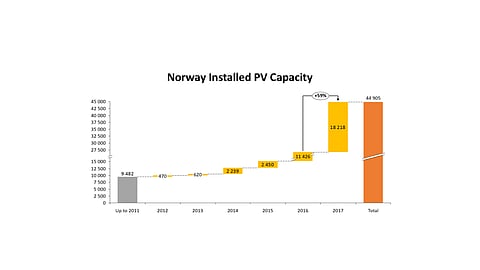

With 18 MW of new PV capacity installed in 2017, Norway managed to take its cumulative PV capacity to 44.9 MW by the end of December 2017. According to a report Solcellesystemer og sol I systemet by consulting firms Multiconsult and Asplan Viak, brought out for local solar association Solenergiklyngen, the newly installed capacity in 2017 represented a 59% growth YoY.
It was preceded by 366% PV installation growth in 2016 compared to the previous year. There is a growing momentum in the adoption of solar power from the commercial and residential segment, according to the report.
The report points out these figures are based on data collected from suppliers, as there is no compulsory registration of installed solar systems in Norway. There is still no clarity as to how many systems have been installed in the residential segment. Having said that, the country is still far off from its Scandinavian neighbors Sweden and Denmark, which installed 60 MW and 70 MW, respectively, in 2016.
The report assumes that if all the roofs in the country were covered by solar PV systems, these would correspond to around 10 TWh of annual generation capacity or 16% of the country's total electricity consumption in 2014.
It expects future energy requirements for buildings to be a big positive driver for PV growth in the country. If the government focuses on formulating schemes to support the industry, it would promote the cause of the industry further. Local companies are working on developing interesting solutions, but most of such innovations are yet to be rolled out into the market.
Going forward, power prices and grid rentals are expected to increase by 2040, which will be good for a market that will thrive on self produced energy.
Te authors of the report suggest that if the Norwegian solar industry wants to maintain its competitive advantages in the field, it must continue to carry out research and development activities. The detailed report is available on the website of Solenergiklyngen.
Last year, US based think tank IEEFA suggested Norway to invest 190 billion NOK ($25 billion) into a renewable energy portfolio from government pension fund (see Norway Should Allocate More Govt Funds For RE).
.png?w=50&fm=png)